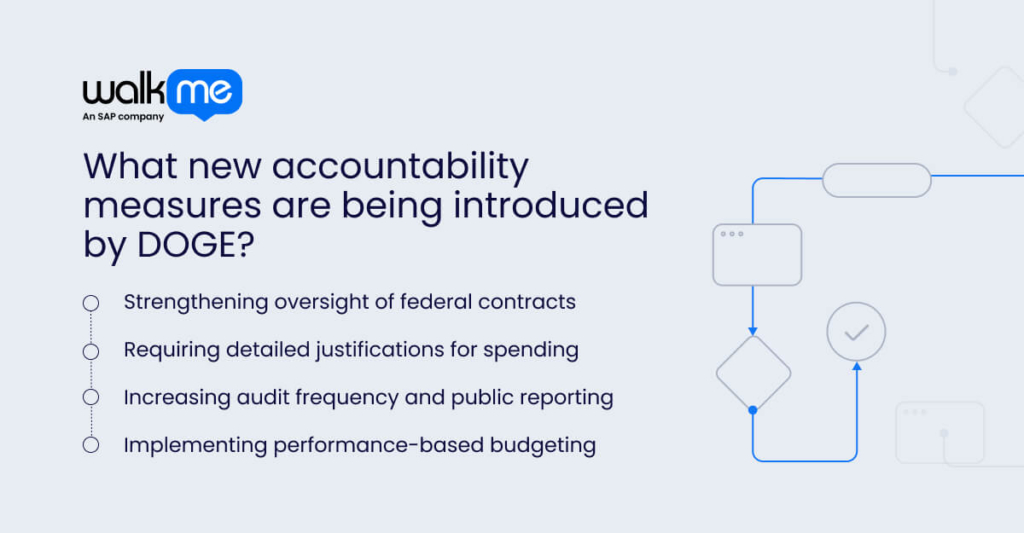The Department of Government Efficiency (DOGE) is a federal initiative dedicated to modernizing how government works, making public services faster, simpler, and more cost-effective. Backed by a team of policy experts and technologists, DOGE focuses on eliminating bureaucratic waste, streamlining outdated systems, and improving how agencies serve the public.
Rather than layering on more red tape, DOGE introduces smart solutions, like automated workflows, real-time performance tracking, and data-driven policy updates, to help agencies deliver measurable results. From procurement to public access portals, the department is reshaping how institutions operate behind the scenes.
As demands on government grow, DOGE is pushing for a more responsive, transparent, and accountable system—one that meets the needs of citizens without compromising on efficiency or oversight.
What is the Department of Government Efficiency (DOGE)?
DOGE is a federal department created to help government agencies work smarter. It partners with organizations across federal, state, and local levels to simplify operations, reduce waste, and speed up service delivery.
The department uses tools like AI-powered data management, business process automation, and cloud transformation to modernize core functions. Whether it’s reducing paperwork, optimizing resource use, or improving interagency coordination, DOGE is focused on outcomes that benefit the public.
At its core, DOGE aims to build a more agile and efficient government—one that earns public trust by making more innovative use of time, technology, and taxpayer dollars.
Who leads DOGE, and what are their backgrounds?
DOGE operates under a unique leadership structure that has evolved over time, shaped by its roots in public-private collaboration and its emphasis on innovation over bureaucracy.
Unlike traditional federal agencies, DOGE blends formal government roles with contributions from outside experts and entrepreneurs, which makes its leadership more fluid and adaptive.
Below, we’ve broken down the DOGE leadership board and outlined key figures, their roles, and how each contributes to the project’s direction and development:
- Donald J. Trump (President of the United States): President Trump established the DOGE via executive order in January 2025, aiming to modernize federal operations through innovation, accountability, and bold reforms.
- Amy Gleason (DOGE Service Administrator): As the acting administrator of DOGE, Amy Gleason leads the department’s operational agenda. Her work focuses on improving internal systems and eliminating waste across federal agencies.
- Steve Davis (Strategic Contributor to DOGE): Steve Davis identifies inefficiencies across federal agencies and enforces cost-saving solutions at DOGE. He focuses on streamlining operations, simplifying systems, and delivering practical reforms that improve government performance.
- Brad Smith (DOGE Leader and Healthcare Entrepreneur): Brad Smith co-leads the Department of Government Efficiency (DOGE), focusing on healthcare reform. A former director of the Center for Medicare & Medicaid Innovation, he now spearheads initiatives to streamline federal healthcare programs.
- Elon Musk (Senior Advisor to the President): Elon Musk is a businessman and senior advisor to DOGE, contributing to efficiency initiatives. While his authority is debated, President Trump values his input and supports his continued involvement.
How does DOGE plan to achieve cost savings and improve government efficiency?

DOGE focuses on rethinking government processes by identifying inefficiencies and implementing smarter solutions across federal agencies. The department aims to cut unnecessary costs while ensuring more effective service delivery through technology adoption and streamlined IT operations.
Let’s take a closer look at how DOGE plans to achieve cost savings and improve government efficiency:
Implementing strategic procurement reforms
To save money and improve efficiency, DOGE is focusing on more innovative ways for the government to buy goods and services. This means eliminating unnecessary steps, cutting out intermediaries, and ensuring the government gets the best deal.
Improving contract negotiation means DOGE can ensure taxpayer money is spent wisely. These changes also help deliver products and services faster, avoiding delays and extra associated costs. With better planning and foresight, the government can make purchases that are more beneficial to the public while staying within the budget.
Enhancing transparency and accountability in spending
DOGE works to make government spending more transparent and accountable. This means clearly showing where money is being spent and ensuring it’s used correctly. Tracking expenses, such as IT cost optimization and sharing information, lets the public see how taxpayer dollars are being spent.
Ensuring accountability in government spending is crucial for preventing waste and fraud. The Department of Government Efficiency (DOGE) plays a significant role by promoting transparency and implementing reforms to enhance fiscal responsibility across federal operations.
Streamlining workforce operations and reducing redundancies
Simplifying workforce operations and reducing redundancies helps the government run more efficiently. DOGE works to remove unnecessary tasks and jobs that overlap, ensuring each position has a clear purpose. This means fewer wasted resources and less confusion between agencies.
Combining similar tasks helps the government function more strategically, improving coordination and maximizing the impact of every resource. When everyone is focused on core responsibilities, the government can deliver more effective and efficient services to the public. These changes create a more accountable and digital government strategy that can address challenges quickly and focus on high-priority projects directly impacting citizens.
How much is the Department of Government Efficiency (DOGE) expected to save?
DOGE is expected to save $150 billion through asset sales, contract cancellations or renegotiations, fraud and improper payment reductions, and unnecessary grant cuts. Additional savings come from program changes, regulatory changes, and workforce reductions. On average, each taxpayer could save about $931.68. Following government rules, these savings will be tracked and shared publicly.
A portion of these savings, including contracts and grants, has already been posted on the official DOGE “savings” page, with updates being made regularly. Over time, these updates will become more real-time.
How is DOGE increasing transparency around government spending?
DOGE has a lot on its plate, specifically enhancing transparency in government spending. It’s unsurprising, given the complex nature of federal expenditures, which often involve various award packages with differing oversight requirements.
With that in mind, let’s take a closer look at how DOGE is increasing transparency around government spending:
Implementing real-time public spending disclosures
DOGE is working to make government spending more open by sharing real-time data on how taxpayer money is used. This means people can see up-to-date information about government expenses as soon as it’s available.
Giving the public easy access to this data, DOGE helps build trust and digital resilience, ensuring that government agencies use funds responsibly. Real-time updates also make it harder for money to be misused, helping to keep the government accountable.
Standardizing financial reporting across agencies
Right now, government agencies report their spending differently, making it hard to compare or understand how money is being used. DOGE is changing to create a standard way of reporting spending across all agencies.
This means everyone will use the same format, making it easier for the public and officials to track where the money goes. A uniform approach to reporting helps civil servants understand the nuances of government spending and accounting for how resources are allocated across various programs and services.
Utilizing technology to enhance data accessibility
DOGE is using technology to make government spending data easier for everyone to access. Putting this information online lets people quickly find and understand how money is spent.
This approach drives digital adoption within the government, making it easier for citizens to track how their tax dollars are spent. Digital tools make the government more transparent, allowing the public to access real-time financial data.
What new accountability measures are being introduced by DOGE?

DOGE has been established to implement new accountability measures to enhance transparency and fiscal responsibility. These changes mark a significant shift in how public institutions are expected to track, report, and justify their resource use.
Let’s take a closer look:
Strengthening oversight of federal contracts
DOGE is focusing on improving how the government manages contracts with private companies. They’re introducing tighter rules to ensure contracts are awarded properly and taxpayers’ money is used wisely.
This approach helps prevent fraud or waste, ensuring that contracts serve the public’s best interest. With better monitoring and checks, the government can guarantee that contractors meet their obligations and that taxpayers get a good return on taxpayer dollars.
Requiring detailed justifications for spending
To increase transparency, DOGE requires government agencies to explain how they plan to spend taxpayer money. This means each project or program must have a well-documented reason for its cost.
Agencies must justify their spending decisions, showing how they benefit the public and align with government priorities. This measure makes it harder for funds to be spent without proper review, ensuring that every dollar spent is accounted for and serves a purpose.
Increasing audit frequency and public reporting
DOGE is ramping up the frequency of federal program audits to increase fiscal accountability. Regular audits are essential for checking whether taxpayer money is being used as planned. Increasing the frequency of these audits, DOGE aims to catch any issues early before they become more significant problems.
These audits also help identify areas where the government can save money or improve procedures. DOGE will make the findings publicly available, allowing everyone to see how funds are being spent and whether agencies are meeting their goals. This creates more confidence in government actions, essential in an era of mass misconduct and heightened public scrutiny.
Implementing performance-based budgeting
DOGE is introducing performance-based budgeting, which ties funding directly to results. Instead of just allocating money based on past budgets, agencies will now receive funds based on their ability to meet specific goals and deliver measurable outcomes. This encourages departments to be more efficient, as they will only get more money if they can prove their success.
It also ensures that valuable taxpayer dollars are spent on programs that show positive results. With this system, the government can prioritize projects with the most impact, ultimately leading to better services for citizens.
What is the projected timeline for DOGE’s operations and expected outcomes?
The timeline below outlines DOGE’s projected milestones and operations, drawing from sources such as official White House announcements and reports from doge.gov.
It provides insights into DOGE’s goals of reducing federal spending and improving government efficiency, though future projections beyond 2026 remain uncertain.
Some savings figures have faced scrutiny, and the timeline beyond 2026 remains speculative and subject to change.
| Year | Milestone | Expected Outcome |
| 2024 | Establishment of DOGE. Initial reforms and organizational setup. | Initial framework for savings and efficiency measures is set up |
| 2025 | First-year savings target of $377 billion. Begin audits and contract renegotiations. | Substantial savings through asset sales and workforce reductions. Improved transparency through public disclosures |
| 2026 | Major program and workforce reductions. Release of first major transparency reports. | Completion of first wave of cost-cutting measures. Enhanced public trust through transparency and accountability reports |
| 2027 | Full implementation of performance-based budgeting across all agencies. Ongoing asset sales and audit cycles. | Ongoing optimization of government functions. Performance-driven budgeting models in place. |
| 2028 | Long-term impact analysis. Reinvestment of savings into key public services and infrastructure. | Sustained improvements in government efficiency. Public services reinvigorated through reinvested savings. |
The road ahead for DOGE: A smarter, more transparent government
The Department of Government Efficiency (DOGE) is poised to reshape the federal government by leveraging innovation and technology to drive smarter, more transparent operations.
Under the leadership of Amy Gleason and key advisors like Elon Musk, DOGE is tasked with rethinking government functions and reducing inefficiencies. Despite the controversy surrounding Musk’s advisory role, his involvement reflects a push to modernize federal processes.
Experts in Congress have emphasized that the government’s inefficiencies have been a long-standing issue, and DOGE’s establishment marks a significant shift toward proactive reform.
As technology evolves, digital efficiency stands at the frontier of this transformation. DOGE’s goal is to help government agencies eliminate wasteful practices and streamline operations, enabling departments to focus on core missions.
DOGE aims to align the government with the digital age, ensuring a more accountable and efficient use of taxpayer resources while driving cost savings and boosting public confidence in federal operations.
FAQs
Government efficiency means using time, money, and resources in the most innovative way possible to deliver better services. It’s about cutting waste, speeding up slow processes, and ensuring programs work while helping citizens with faster services, clearer information, and fewer delays.
DOGE partners with federal agencies and contractors to find better ways to do their jobs. It helps them use new tools, fix outdated systems, and save money. DOGE doesn’t replace them—it partners with them to make government work faster, smarter, and more openly for everyone.
The Unconstitutionality Index tracks how often courts reject federal rules for going beyond legal limits. A high score means too many overreaching rules. This index helps DOGEs and agencies rethink regulations, ensuring they follow the law and protect people’s rights while still doing their jobs.

